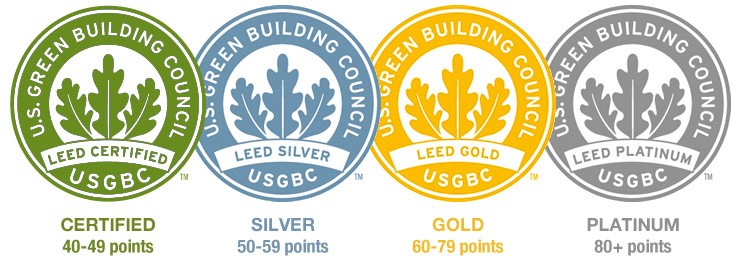As humans continue to evolve, it is becoming increasingly important to change our habits and become more sustainably aware of our impact on this earth. Many people are looking for ways to conserve energy and preserve resources. The Leadership in Energy and Environmental Design (LEED) is one program that fulfills this goal and has gained popularity recently. The main objective of LEED certification is to change the way we design and operate buildings. Run through the U.S. Green Building Council and created to define high performance green buildings, the program sets goals, recognizes leaders, promotes improvement, and raises consumer awareness by qualifying a building’s performance based on various categories (Construction Corner).
LEED Certification Rating Systems
In order to become LEED certified, buildings need to satisfy prerequisites that earn them points for different certification levels. The four certification categories are Certified (40-49 points), Silver (50-59 points), Gold (60-79 points), and Platinum (80+ points).
To earn these points, construction contractors must receive credit in the following “credit categories”:
Integrative Process: incorporates diverse credit categories during the pre-design process.
Location and Transportation: credits are awarded to projects in areas close to a variety of transportation options such as a bus, streetcar, rail or ferry.
Materials and Resources: credits given to buildings that reduce waste and have good indoor environmental quality (i.e. good air quality and daylight views).
Water Efficiency: credits promote smarter use or water to lower overall water consumption.
Energy and Atmosphere: credits encourage better building energy strategies through innovative methods.
Sustainable Sites: credits are given to minimize impacts on ecosystems and water sources.
Indoor Environmental Quality: credits are allotted to buildings with better indoor air quality and daylight views.
Innovation: credits cover design measures that might not be in the other credit categories.
Regional Priority Credits: addresses regional environmental properties for diverse geographical regions.
LEED Costs
Being “green” can sometimes come with a cost, and in the case of LEED certification, the fees can certainly add up. The Green Building Certification Institute issues fees that can roughly amount up to $0.03-$0.05 per square foot. Then, LEED requires all buildings to go through a documentation management process, which may entail hiring an outside consultant. Hiring a design team to develop and price a range of scenarios for the building will cost anywhere from $0.50-$1.00 per square foot. The biggest LEED expense, however, will be the construction itself.
If these costs seem to sway your decision away from the LEED program, you should remember that making a building or your home more sustainable will ultimately save you money in the long-run AND is more beneficial for the environment!
The Triple Bottom Line
The LEED program functions by implementing the “triple bottom line” (TBL) method. The triple bottom line started when John Elkington tried to measure corporate America’s sustainability in the mid-90’s. TBL is an accounting framework that incorporates the performance of social, environmental, and financial categories. The tricky thing about this method is determining how to measure it. One proposed solution is to create an index to compare performance between companies, cities, development projects, etc. Other options have been to use dollars and progress that would be gauged on wetland creation or destruction over time.
The primary organizations that use TBL are businesses, non-profits, and government entities. Businesses are generally interested in TBL because they want to achieve general long-term profitability. Many non-profits have goals of economic prosperity in regards to social well-being and environmental protection. And governments use TBL as a monitoring tool. Policy makers can determine what policies make society more sustainable. Examples of TBL being used in the U.S. include the Sustainable Cleveland 2019 Summit, which strived to create a more sustainable economy in Cleveland with the TBL in mind, and Grand Rapids, who also attempted to measure their TBL in hopes of leading to a more sustainable environment.
Ultimately, TBL has changed the ways businesses, non-profits, and governments measure sustainability. It allows organizations to look at their choices and decisions from a long-term perspective. This is why TBL aligns so well with the main objective of LEED projects. They strive to promote sustainability and reduce the amount of resources that are needlessly wasted every day.
The LEED program is improving the construction industry by creating incentives for companies to innovate buildings in new sustainable ways (Countertop Specialists). With the program’s popularity, manufacturers are thinking of new ways to build within LEED requirements all the time. Because of this, the program will eventually translate into renewable and affordable products for the general public. Green materials can then be practically used by all residents. It is becoming clear that LEED certification is changing the structure of buildings as we know it!
[sdonations]2[/sdonations]


